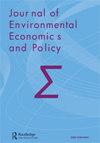Assessing regional convergence of greenhouse gas emissions in Spain: insights from economic activities
IF 1.2
Q3 ENVIRONMENTAL STUDIES
Journal of Environmental Economics and Policy
Pub Date : 2023-10-30
DOI:10.1080/21606544.2023.2272822
引用次数: 0
Abstract
ABSTRACTIn recent decades, Spain has undergone a strong economic expansion; however, it has not made a robust response to fulfil the international greenhouse gas Paris Agreement targets. Thus, understanding the dynamics of the environmental performance of the Spanish regions is essential for policymakers. We explore the convergence process of emissions intensity at the regional level during 1990–2018, differentiating between direct and diffuse emission sector, based on the degree of energy intensity of economic activities, which is the most novel aspect of our analysis. Our results recognise several convergence clubs; predominantly, the determining factors are income level and added value breakdown, the energy mix of renewable power, as well as the temperature of the climate. In any event, the dispersion of behaviours and the existence of different factors driving the convergence process highlight the need for customised policies at the regional scale.Key Policy HighlightsCustomised environmental policies are vital for regions in Spain with varying emissions levels.National consensus is needed to reduce emissions across industries, transportation, businesses, households, and agriculture.Targeted development can mitigate environmental impact, aiding policymakers.Regions that are falling behind should prioritise renewable energy promotion.Energy conservation laws must be mandatory henceforth.KEYWORDS: Emission intensityconvergenceclubs/clusterssectorsSpain Disclosure statementNo potential conflict of interest was reported by the author(s).Data accessibility statementThe data that support the findings of this study are available from the corresponding author upon reasonable request.Notes1 The figures for the autonomous cities are not shown individually because of their low degree of representation. In this manner, our subsequent analysis always has 18 regions, the last one being the combination of Ceuta and Melilla (CYM).2 The smoothing parameter, λ, of the Hodrick-Prescott filter should be adjusted when changing the frequency of observations which can affect the results of filtering (Ravn and Uhlig Citation2002). We have defined λ= 400 as noted (Phillips and Sul Citation2009). Results do not change significantly with λ=100 for annual data.评估西班牙温室气体排放的区域趋同:来自经济活动的见解
近几十年来,西班牙经历了强劲的经济扩张;然而,在实现《巴黎协定》的国际温室气体减排目标方面,中国并没有做出强有力的回应。因此,了解西班牙地区环境绩效的动态对政策制定者至关重要。基于经济活动的能源强度程度,我们探索了1990-2018年区域层面排放强度的收敛过程,区分了直接和扩散排放部门,这是我们分析中最新颖的方面。我们的结果承认几个收敛俱乐部;主要的决定因素是收入水平和附加值分解、可再生能源的能源结构以及气候温度。无论如何,行为的分散和推动趋同过程的不同因素的存在突出表明需要在区域范围内制定定制的政策。针对西班牙不同排放水平的地区,量身定制的环境政策至关重要。减少工业、交通、商业、家庭和农业的排放需要全国共识。有针对性的发展可以减轻环境影响,帮助决策者。落后地区应优先推广可再生能源。从此以后,节能法必须是强制性的。关键词:排放强度趋同俱乐部/集群部门西班牙披露声明作者未报告潜在利益冲突。数据可及性声明支持本研究结果的数据可根据通讯作者的合理要求提供。注1由于自治城市的代表性较低,故未单独列出。这样,我们的后续分析始终有18个区域,最后一个区域是休达和梅利利亚的组合(CYM)当改变观测频率时,应调整Hodrick-Prescott滤波器的平滑参数λ,这可能会影响滤波结果(Ravn和uhlight Citation2002)。我们已经定义了λ= 400,如前所述(菲利普斯和Sul Citation2009)。对于年度数据,λ=100时结果没有显著变化。
本文章由计算机程序翻译,如有差异,请以英文原文为准。
求助全文
约1分钟内获得全文
求助全文
来源期刊

Journal of Environmental Economics and Policy
ENVIRONMENTAL STUDIES-
CiteScore
4.70
自引率
7.70%
发文量
26
 求助内容:
求助内容: 应助结果提醒方式:
应助结果提醒方式:


